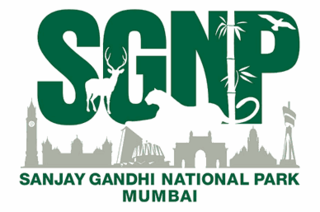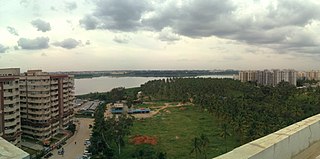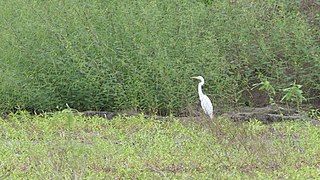
Sanjay Gandhi National Park is an 87 km2 (34 sq mi) protected area in Mumbai, Maharashtra. It was established in 1969 with its headquarters situated at Borivali.

Sankey tank, a manmade lake or tank, is situated in the western part of Bangalore in the middle of the neighbourhoods of Malleshwaram, Vyalikaval and Sadashivanagar. The lake covers an area of about 15 ha. At its widest, the tank has a width of 800 m (2,624.7 ft).

Kolleru Lake is one of the largest freshwater lakes in India and forms the largest shallow freshwater lake in Asia. 15 kilometers away from Eluru and 65 km from Rajamahendravaram, the lake is located between the Krishna and Godavari river deltas. Kolleru Lake is located in the Eluru district in the state of Andhra Pradesh. The lake is fed directly by water from the seasonal Budameru and Tammileru rivulets, and is connected to the Krishna and Godavari irrigation systems by over 67 major and minor irrigation canals. This lake is a major tourist attraction. Many birds migrate here in winter, such as Siberian crane, ibis, and painted storks. The lake was an important habitat for an estimated 20 million resident and migratory birds, including the grey or spot-billed pelican. The lake was declared as a wildlife sanctuary in November 1999 under India's Wildlife Protection Act of 1972, and designated a wetland of international importance in November 2002 under the international Ramsar Convention. The wildlife sanctuary covers an area of 308 km2.
Puttenahalli WS Lake also spelled as Puttanahalli Lake is a 10-hectare water body near Yelahanka, 14 km north of Bangalore.

Tholkappia Poonga or Adyar Eco Park is an ecological park set up by the Government of Tamil Nadu in the Adyar estuary area of Chennai, India. According to the government, the project, conceived based on the master plan for the restoration of the vegetation of the freshwater ecosystems of the Coromandel Coast, especially the fragile ecosystem of the Adyar estuary and creek, was expected to cost around ₹ 1,000 million which will include the beautification of 358 acres of land. The park's ecosystem consists of tropical dense evergreen forest, predominantly comprising trees and shrubs that have thick dark green foliage throughout the year, with over 160 woody species, and comprises six vegetative elements such as trees, shrubs, lianas, epiphytes, herbs and tuberous species. The park was opened to public by Chief Minister M. Karunanidhi on 22 January 2011 and named after the renowned Tamil scholar Tholkappiar. About 65 percent of the park is covered by water and artefacts and signages. In the first 2 months of its inauguration, nearly 4,000 children from several schools in the city and the nearby Kancheepuram and Tiruvallur districts have visited the park to learn about wetland conservation, eco-restoration and water management. While the first phase of the ecopark covered about 4.16 acres of CRZ-III area, the entire area covered under the second phase falls under this category.
Lakes and tanks in the metropolitan area of Greater Bangalore and the district of Bangalore Urban are reservoirs of varying sizes constructed over a number of centuries by various empires and dynasties for rainwater harvesting. Historically, these reservoirs were primarily either irrigation tanks or for the water supply, with secondary uses such as bathing and washing. The need for creating and sustaining these man-made dammed freshwater reservoirs was created by the absence of a major river nearby coupled with a growing settlement. As Bangalore grew from a small settlement into a city, both of the primary historical uses of the tanks changed. Agricultural land witnessed urbanization and alternate sources of water were provisioned, such as through borewells, piped reservoir water and later river water from further away.

Vellayani Lake, or Vellayani Kayal, is the second largest freshwater lake in the state of Kerala and is situated in Thiruvananthapuram, Kerala, India. In ancient times, boats laden with goods used to navigate the Vellayani backwaters up to Chala.

Bellandur Lake is located in the suburb of Bellandur in the southeast of the city of Bengaluru. It is the largest lake in the city. It is a part of Bellandur drainage system that drains the southern and the south-eastern parts of the city. The lake is a receptor from three chains of lakes upstream, and has a catchment area of about 148 square kilometres. Water from this lake flows further east to the Varthur Lake, from where it flows down the plateau and eventually into the Pinakani river basin.

Agara lake is an 80-acre lake located in Agara, Bangalore. It is part of the Varthur lake series. Madiwala Lake is upstream while Bellandur Lake is downstream. Inter-lake connections have seen fragmentation and urbanisation.
Singanallur Lake is a lake in Singanallur, Coimbatore, South India. It is spread over an area of 1.153 km2 (0.445 sq mi) and has an average depth of 4.25 m (13.9 ft). It is one of the 9 large lakes in the city.
Yelahanka Lake is a water body near Yelahanka, a suburb of Bangalore.

Durgam Cheruvu, also known as Raidurgam Cheruvu, is a freshwater lake located in Rangareddy district, Telangana, India. The lake, which is spread over 83 acres (34 ha), is located near the city of Hyderabad. The lake is also known as Secret Lake because it is hidden between the localities of Jubilee Hills, Madhapur and Raidurg. The Durgam Cheruvu Bridge, which traverses the lake, was inaugurated in September 2020.

Saroornagar Lake is a lake in Hyderabad, India. From the year of its creation in 1626, the lake remained largely clean until 1956 when Hyderabad expanded. Spread over 99 acres (40 ha), the lake was restored by the Hyderabad Urban Development Authority in 2003–04 at a cost of ₹200 million (US$2.4 million). After the restoration of the lake, migratory birds returned to the lake in large numbers a few years later.

Housing more than 200 resident and wintering bird species, Chennai has long been a haven for bird watchers. It is one of the few urban areas in India with diverse range of birds including greater flamingo, black baza, osprey, Indian eagle-owl, Coppersmith barbet, Spot billed pelican and pied avocet can be seen. The following are some known birding hotspots in and around Chennai.

Chitlapakkam aeri, or Chitlapakkam lake, is an urban lake located in Chitlapakkam, Chennai, India. It is the chief water body in the neighbourhood. Originally measuring 86.86 acres, the lake has currently shrunken to 46.88 acres. The lake was last restored in 2003.

The Thurahalli Forest or Thurahalli Park is a dry and deciduous forest. It is located about 20 km from Bengaluru off Kanakapura Road. It is 13 km from Banashankari and can be overseen from the NICE road. Entry inside the park has been banned for vehicles, however, it has become a hot spot for cyclists.
Arekere Lake is situated in the Arekere - Hulimavu area of the city of Bangalore. Originally spread over an area of approximately 37 acres, the lake is bounded on the west by Bannerghatta Road, on the north by BDA Eighty Feet Road, on the east by Shantinikethan Layout and on the south by Hulimavu Main Road. According to the BBMP website, the perimeter of the lake is about 3 kilometres (1.9 mi). It was possibly a manmade water reservoir created approximately 100 years ago.

Hebbal Lake is a lake in the city of Mysore, India.
Vellalore Lake is a lake in Coimbatore, Tamil Nadu. The lake is spread over an area of 90 acres and the green zone around the lake attracts over 80 species with its native trees and flowers. After being dry for over two decades, the lake came alive again in 2018 due to the efforts of the district administration and NGOs. In April 2023, Kovai Kulangal Padhukappu Amaippu and the district administration launched work to set up a Butterfly Park.

Oussudu or Ousteri Bird Sanctuary is the first and the only wildlife sanctuary in the Indian union territory of Puducherry. It was created in 2018. It spans over 390 acres around the Ousteri lake.















